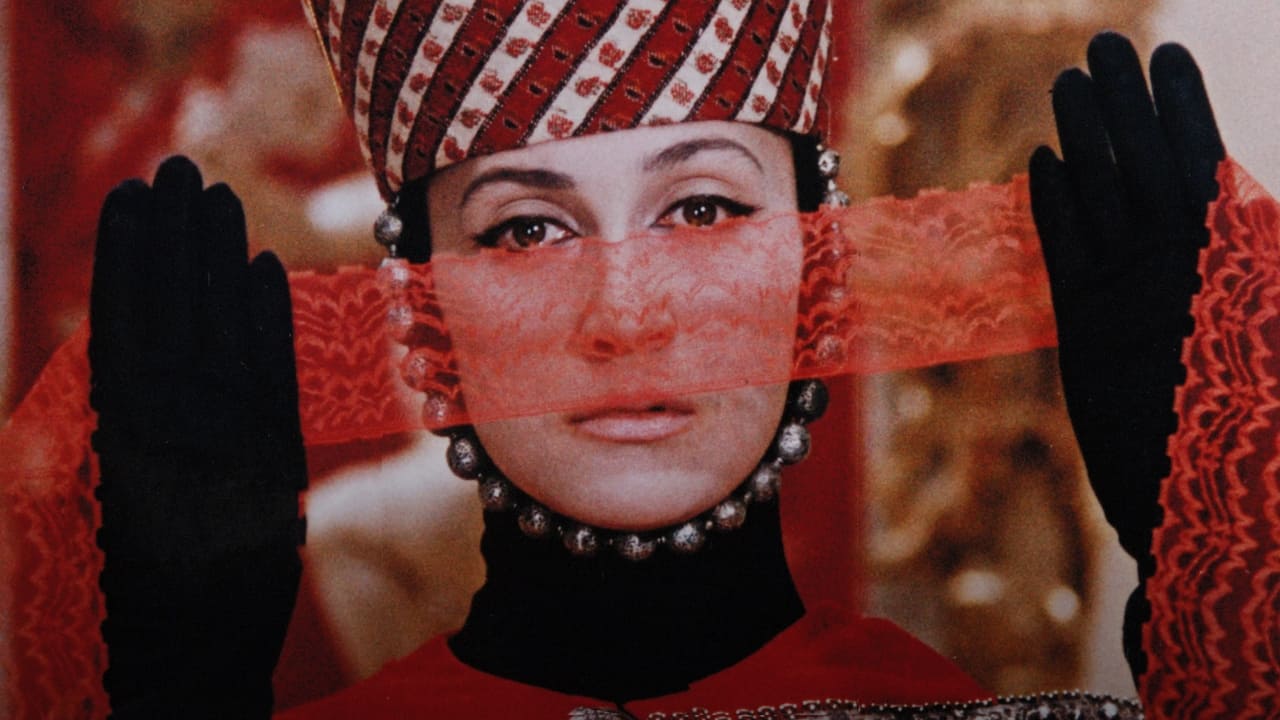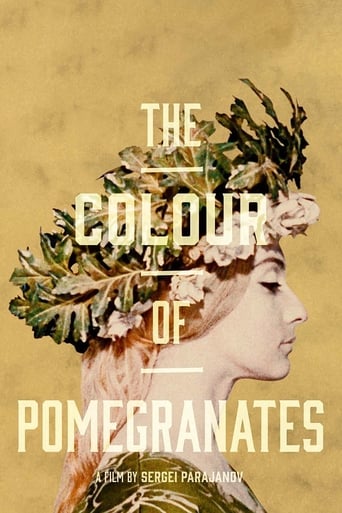



The film makes a home in your brain and the only cure is to see it again.
View MoreYour blood may run cold, but you now find yourself pinioned to the story.
View MoreThis is a coming of age storyline that you've seen in one form or another for decades. It takes a truly unique voice to make yet another one worth watching.
View MoreJust intense enough to provide a much-needed diversion, just lightweight enough to make you forget about it soon after it’s over. It’s not exactly “good,” per se, but it does what it sets out to do in terms of putting us on edge, which makes it … successful?
View MoreTHE COLOR OF POMEGRANATES (Armenian, Նռան գույնը) -- AKA "Sayat Nova", Viewed at 2014 Yerevan Golden Apricot IFF Director, Sergei Parajanov, 1968. RT 79 minutes. Languages of the poetry: Armenian, Geogian and Azeri Turkish 32E0CC90-FBBD-4A04-9EF6-1C87A431AD42 Generally regarded as one of the greatest masterpieces of the 20th century, the "Color of the Pomegranates" is a dazzling pictographic biography of the famous 18th century Armenian troubadour Sayat Nova (King of Song) revealing the poet's life more through the visualization of his poetry than a conventional narration of the events of his life. Or, one might even say that Parajanov simply used the poetry of Sayat as a launching pad to trip out on his own kind of unique cinematic poetry. However you look at it the result is a memorable film experience. The eleventh annual installment of the Yerevan International Film Festival opened last night with a grandiose red carpet invitational gala at the Yerevan opera house and the screening of a digitally restored print of this magnificent but all too rarely seen film, a one of a kinder that resists classification. The Color of Pomegranates is in structure a metaphoric biography of the many sided prolific Armenian poet, musician, courtier, and eventually monk, Ashug Sayat-Nova, (King of Song) revealing the stages of his fantastic life visually and poetically rather than literally. The film is presented as a virtually silent movie with active tableaux depicting Sayat's life in eight chapters: Childhood, Youth, The Court of the prince, The Monastery, The Dream, Old Age, The Angel of Death and Death. There are sounds and music and occasional singing but almost no dialogue. Each chapter is indicated by a title card and framed through both the director's imagination and Sayat Nova's poems. Georgian actress Sofiko Chiaureli plays six roles in the film, both male and female.Among other things this film celebrates the survival of Armenian culture in the face of oppression and persecution. Sayat was executed and beheaded when he refused to renounce his Armenian Christianity before conquering Persian invaders. Visually luscious with many images that are highly charged such as blood-red juice spilling from a cut pomegranate onto a cloth and forming a stain in the shape of the boundaries of the Ancient kingdom of Armenia -- dyers lifting planks of wool out of vats in the colors of the national flag, and so forth ... This film is on many critical lists of the greatest films of all time. A dazzling festival opener. Parajanov, who was a maverick Soviet film director working often in the Ukraine and Georgia was constantly hounded by the Soviet establishment, but he is a national hero here in Armenia with a museum devoted entirely to him alone. His abstract non- linear films were regarded as provocations by the Soviet censors who couldn't even understand them but assumed that they must be subversive because Parajanov himself absolutely refused to toe the party line in his private or artistic life. As a result he had to spent much time in Soviet jails which limited his total output, but all of his films are regarded as landmarks of one kind or another and will all be shown here, an unusual opportunity to catch up with the rarely seen works of a little known cinema master.
View Moreone of films who could represent rare examples of profound gracious beauty. because it is an embroidery of image and sound and civilization, a refined homage to a great Armenian poet. and the high point of Paradjanov work. a gem of wise trip in heart of things. a film for memories. for the admirable style to use pieces from old fairy tales and dreams, for the splendid science to use the silence as key for discover profound emotions, as definition of life and spirit, creation and fate. The Color of Pomegranates is more than an art film. it is an experience. and affirmation of an cinema art who remains, after decades, unique, profound, seductive scene by scene.
View MoreFor those who need an American equivalent to compare to, it is similar to the work of Brakhage or Anger, the American experimental filmmakers.It is not Hollywood in that the movie does not rely on a plot, although there is a semblance of one present in this particular movie. The life and poetry of Sayat Nova, the great Medieval Armenian Troubadour, albeit abstractly, is the basis for all the images presented. It is also not Hollywood in that there is no dialog. The interest rests in the unforgettable and arresting images, lovingly created and edited together in the manner of Eisenstein. So in this regard it has more in common with silent film.Yes, this is an abstract film. Yes, it is pretentious. But what is wrong with that? Prtensious is, after all, what most call something that they have a hard time understanding. Make no mistake, this is an art film to the extreme. A film whose primary concern is not to entertain, but rather to express Parajanov's personal view of Sayat Nova,and more importantly, to preserve to film the medieval Armenian culture which was almost completely eradicated in the Armenian Massacre of 1915 at the hands of the Turkish Empire. This film is historically important for this reason alone. The fact that Parajanov was imprisoned by the Russian Government for not conforming to the strict Social Realist code of film underscores this point. This film was a slap in the face to Communist Russia which wanted to erase the old traditions. There is nothing much you have to get to enjoy this film, except to marvel at images inspired by an ancient little known culture. There is a lot of beauty in these images which probably seem so foreign and alien to Westerners. That is the point. That is the effect that I believe Parajanov is after. Those that don't get it either lack patience and subtlety, or are under the mistaken assumption that good films must follow the American Hollywood script model. The latter would be making the same mistake as the Russians who put Parajanov in the Gulag. No one who as seen even a bit of this film, could deny that it is unforgettable. And that is what to me makes a good film.
View MoreI stopped watching at "Grief, Grief, Grief". This is the worse film imaginable. Pretentious, boring, simply awful. I would have sent the Director to the Gulag just for the 30 minutes I was unfortunate enough to see. It is astonishing that this film has received so many positive votes. I watched the film with a roomful of film buffs and everybody was hurling abuse at the television after just 15 minutes! I had to switch the film off as I was afraid someone would throw it out of the window. Parajanov obviously really liked the poet that this film is an ode to, but unfortunately it doesn't change how I feel about it. He is no Tarkovsky!
View More